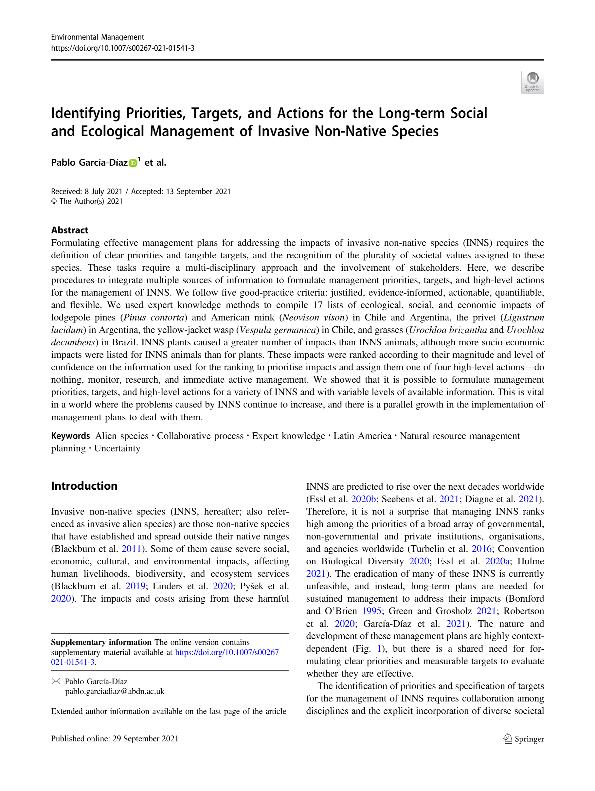Artículo
Identifying Priorities, Targets, and Actions for the Long-term Social and Ecological Management of Invasive Non-Native Species
García Díaz, Pablo; Montti, Lia Fernanda ; Powell, Priscila Ana
; Powell, Priscila Ana ; Phimister, Euan; Pizarro, José Cristóbal; Fasola, Laura
; Phimister, Euan; Pizarro, José Cristóbal; Fasola, Laura ; Langdon, Bárbara; Pauchard, Aníbal; Raffo, Eduardo Alberto; Bastías, Joselyn; Damasceno, Gabriella; Fidelis, Alessandra; Huerta, Magdalena F.; Linardaki, Eirini; Moyano, Jaime
; Langdon, Bárbara; Pauchard, Aníbal; Raffo, Eduardo Alberto; Bastías, Joselyn; Damasceno, Gabriella; Fidelis, Alessandra; Huerta, Magdalena F.; Linardaki, Eirini; Moyano, Jaime ; Nuñez, Martin Andres
; Nuñez, Martin Andres ; Ortiz, María Ignacia; Rodríguez Jorquera, Ignacio; Roesler, Carlos Ignacio
; Ortiz, María Ignacia; Rodríguez Jorquera, Ignacio; Roesler, Carlos Ignacio ; Tomasevic, Jorge A.; Burslem, David F. R. P.; Cava, Mário; Lambin, Xavier
; Tomasevic, Jorge A.; Burslem, David F. R. P.; Cava, Mário; Lambin, Xavier
 ; Powell, Priscila Ana
; Powell, Priscila Ana ; Phimister, Euan; Pizarro, José Cristóbal; Fasola, Laura
; Phimister, Euan; Pizarro, José Cristóbal; Fasola, Laura ; Langdon, Bárbara; Pauchard, Aníbal; Raffo, Eduardo Alberto; Bastías, Joselyn; Damasceno, Gabriella; Fidelis, Alessandra; Huerta, Magdalena F.; Linardaki, Eirini; Moyano, Jaime
; Langdon, Bárbara; Pauchard, Aníbal; Raffo, Eduardo Alberto; Bastías, Joselyn; Damasceno, Gabriella; Fidelis, Alessandra; Huerta, Magdalena F.; Linardaki, Eirini; Moyano, Jaime ; Nuñez, Martin Andres
; Nuñez, Martin Andres ; Ortiz, María Ignacia; Rodríguez Jorquera, Ignacio; Roesler, Carlos Ignacio
; Ortiz, María Ignacia; Rodríguez Jorquera, Ignacio; Roesler, Carlos Ignacio ; Tomasevic, Jorge A.; Burslem, David F. R. P.; Cava, Mário; Lambin, Xavier
; Tomasevic, Jorge A.; Burslem, David F. R. P.; Cava, Mário; Lambin, Xavier
Fecha de publicación:
29/09/2021
Editorial:
Springer
Revista:
Environmental Management
ISSN:
0364-152X
e-ISSN:
1432-1009
Idioma:
Inglés
Tipo de recurso:
Artículo publicado
Clasificación temática:
Resumen
Formulating effective management plans for addressing the impacts of invasive non-native species (INNS) requires the definition of clear priorities and tangible targets, and the recognition of the plurality of societal values assigned to these species. These tasks require a multi-disciplinary approach and the involvement of stakeholders. Here, we describe procedures to integrate multiple sources of information to formulate management priorities, targets, and high-level actions for the management of INNS. We follow five good-practice criteria: justified, evidence-informed, actionable, quantifiable, and flexible. We used expert knowledge methods to compile 17 lists of ecological, social, and economic impacts of lodgepole pines (Pinus contorta) and American mink (Neovison vison) in Chile and Argentina, the privet (Ligustrum lucidum) in Argentina, the yellow-jacket wasp (Vespula germanica) in Chile, and grasses (Urochloa brizantha and Urochloa decumbens) in Brazil. INNS plants caused a greater number of impacts than INNS animals, although more socio-economic impacts were listed for INNS animals than for plants. These impacts were ranked according to their magnitude and level of confidence on the information used for the ranking to prioritise impacts and assign them one of four high-level actions—do nothing, monitor, research, and immediate active management. We showed that it is possible to formulate management priorities, targets, and high-level actions for a variety of INNS and with variable levels of available information. This is vital in a world where the problems caused by INNS continue to increase, and there is a parallel growth in the implementation of management plans to deal with them.
Archivos asociados
Licencia
Identificadores
Colecciones
Articulos(CCT - PATAGONIA NORTE)
Articulos de CTRO.CIENTIFICO TECNOL.CONICET - PATAGONIA NORTE
Articulos de CTRO.CIENTIFICO TECNOL.CONICET - PATAGONIA NORTE
Articulos(IER)
Articulos de INSTITUTO DE ECOLOGIA REGIONAL
Articulos de INSTITUTO DE ECOLOGIA REGIONAL
Articulos(IIMYC)
Articulos de INSTITUTO DE INVESTIGACIONES MARINAS Y COSTERAS
Articulos de INSTITUTO DE INVESTIGACIONES MARINAS Y COSTERAS
Articulos(INCUAPA)
Articulos de INVESTIGACIONES ARQUEOLOGICAS Y PALEONTOLOGICAS DEL CUATERNARIO PAMPEANO
Articulos de INVESTIGACIONES ARQUEOLOGICAS Y PALEONTOLOGICAS DEL CUATERNARIO PAMPEANO
Articulos(INIBIOMA)
Articulos de INST. DE INVEST.EN BIODIVERSIDAD Y MEDIOAMBIENTE
Articulos de INST. DE INVEST.EN BIODIVERSIDAD Y MEDIOAMBIENTE
Citación
García Díaz, Pablo; Montti, Lia Fernanda; Powell, Priscila Ana; Phimister, Euan; Pizarro, José Cristóbal; et al.; Identifying Priorities, Targets, and Actions for the Long-term Social and Ecological Management of Invasive Non-Native Species; Springer; Environmental Management; 69; 1; 29-9-2021; 140-153
Compartir
Altmétricas



